Outlet positions are an important factor to consider in any part of a house, including a basement. Convenient plug points make a big difference to everyday function and utility, but there are also code regulations to consider. It is essential to comply with electrical rules.
How and where you must position your electrical outlets in a basement depends on whether the area is finished, unfinished, and what you are using the space for. You must consider the minimum number of required receptacle outlets, including those for appliances, the height requirements, the spacing requirements, and circuit protection devices.

The code regulations for the positioning of electrical outlets differ depending on whether your basement is finished or not and what purpose it serves. You will need plugs in your basement regardless, but the number and the height regulations are utility-based.
The Difference Between an Outlet, Receptacle Outlet, and Receptacle
Commonly, we refer to the place where you plug your adapter prongs into as an “outlet”. However, in the International Residential Code (IRC), there is a difference between an outlet, a receptacle outlet (otherwise also called an electrical outlet), and a receptacle.
So, for the purposes of understanding the code, I will quickly clarify the difference:
- An outlet refers to the single access point for a branch circuit.
- A receptacle outlet is where you plug something in and is otherwise known as a plug.
- The actual slot where you put plug prongs is a receptacle. It can be a simplex, duplex, or triplex, which means you can have one, two, or three spaces for an adapter to connect to the receptacle outlet/plug.
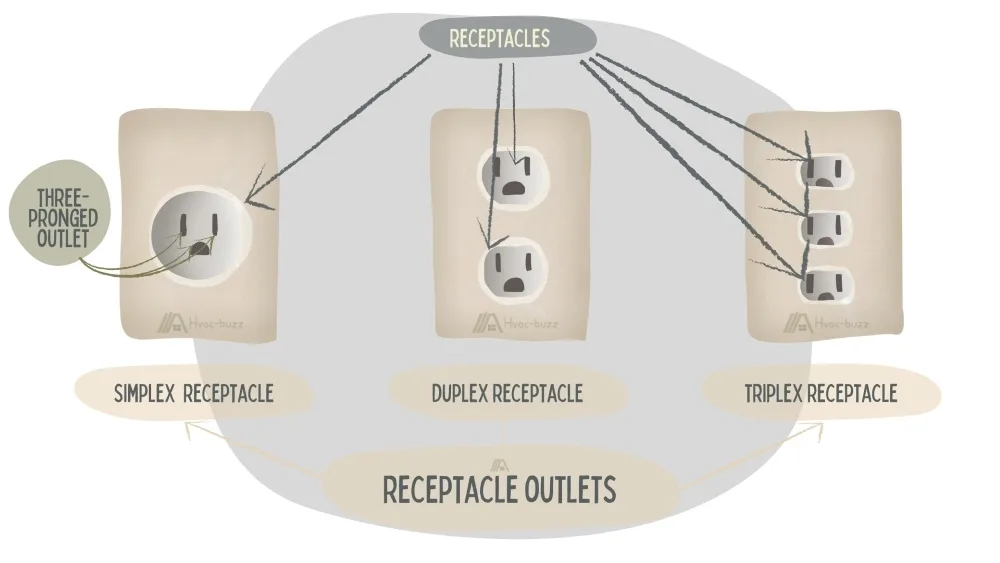
The number of electrical outlets allowed on an electrical circuit is not the same as how many receptacles are allowed, which depending on the plug-in spots, could add up to a lot more than the specified outlet amount without being a problem.
Outlets in Unfinished Basements
Section E3901.9 of the IRC outlines the regulations for electrical outlets in an unfinished basement.
You will need at least one outlet for each separate portion of the basement. This means that you are required to have one or more outlets for any division or separated area in your basement, for example, a DIY basement root cellar.
This one outlet does not include any dedicated outlets. These dedicated outlets are specifically for equipment or appliances that need their own supply because they need to be connected as an independent part of the electrical system.
Laundry Areas in Unfinished Basements
A basement is an ideal place to put your laundry space as it often has the space for the large appliances that other areas of the house lack.
Although the basement is an ideal spot for the laundry room, there are times when you may have to move it to the main floor. If you are looking to make this change, I encourage you to check out my information packet and checklist: Moving Laundry Toom From Basement to Main Floor (Checklist)
Section E3901.8 of the IRC states that a minimum of one electrical outlet shall be installed in an area designated to your laundry appliances and equipment.
You need to make sure there is an outlet for each appliance that needs one, as well as comply with the rule of one outlet per section of an unfinished basement. By giving the appliance its own electrical outlet, it is able to function most optimally and, therefore, most safely.
Take a Detour
Can You Put a Subpanel in a Laundry Room
Unfinished Basements Modified as Garages
There are pros and cons to a basement garage, and this includes an unfinished basement modified as a garage. You have the option of a bigger space for the garage, and you can use your above-ground space for other purposes while still protecting your vehicles from heat and the elements.
It can be expensive to finish a basement garage, so there are some basics you will need to cover to provide a minimalistic modification to your basement. One of these basics is the need for electrical outlets in the garage.
The IRC, Section E3901.9, requires that a receptacle outlet be installed in each of the vehicle bays in an attached garage and detached garage.
The plugs in an attached basement garage must not be higher than 5.5 ft (1676 mm) from the ground.
Outlet Height in Unfinished Basements
Aside from the maximum height restriction for garage outlet receptacles, there are no specifications for the height of an electrical outlet.
If you take a logical standpoint for the position of your electrical outlets, then there are some guiding factors.
If you want to install some of your major household appliances into your basement, then you should consider accessibility. Putting an electrical outlet very low-down in a corner is not going to be conducive for a water heater. Placing the outlet receptacle higher up the wall will help make it easier to access.
Some areas are prone to flooding, monsoons, or hurricanes. If you live in such an area, then you might want to choose a higher positioning for the electrical outlets that are located in your basement.
If your house becomes flooded, the basement will likely be an area where that water will concentrate, and this becomes problematic if your plug points are going to be submerged every time.
You can apply the maximum height for outdoor electrical outlets from Section E3901.7 of the IRC, which says that the upper-most height of an outlet should be 6.6 ft above the grade plane.
While being below the grade plane itself, your basement is an encapsulated area that is meant to keep water out. In this regard, you could apply the maximum height of 6.6 ft to the basement floor.
GFCI Protection Required
Unless the receptacle outlet in your basement only supplies a permanent fire or burglar alarm, you are required to have ground-fault circuit-interrupter (GFCI) protection.
According to Section E3902.5 (IRC):
“125-volt through 250-volt receptacles installed in basements and supplied by single-phase branch circuits rated 150 volts or less to ground shall have ground-fault circuit-interrupter protection for personnel.”
A GFCI is a circuit-breaker that is designed to shut off the electricity at that point if a ground fault occurs. IT is designed to do this fast enough to prevent an issue from arising due to the grounding problem.
This means that in the event of your receptacle outlet becoming damaged in the basement, it will help safeguard you from the harm of an electrical shock.
This is important because unfinished basements may not be as protected from the environment as their finished counterparts. Section E3902.10 states that indoor damp and wet locations require GFCI protection.
If your basement garage is prone to higher amounts of dampness or cold, your electrical outlets are likely to experience more wear and can more easily become compromised.
Outlets in Finished Basements
A finished basement is treated as an above-ground living area and follows the outlet regulations for the house’s upper floors. Keep in mind, that you will more than likely need a permit to finish your basement.
Outlet Spacing
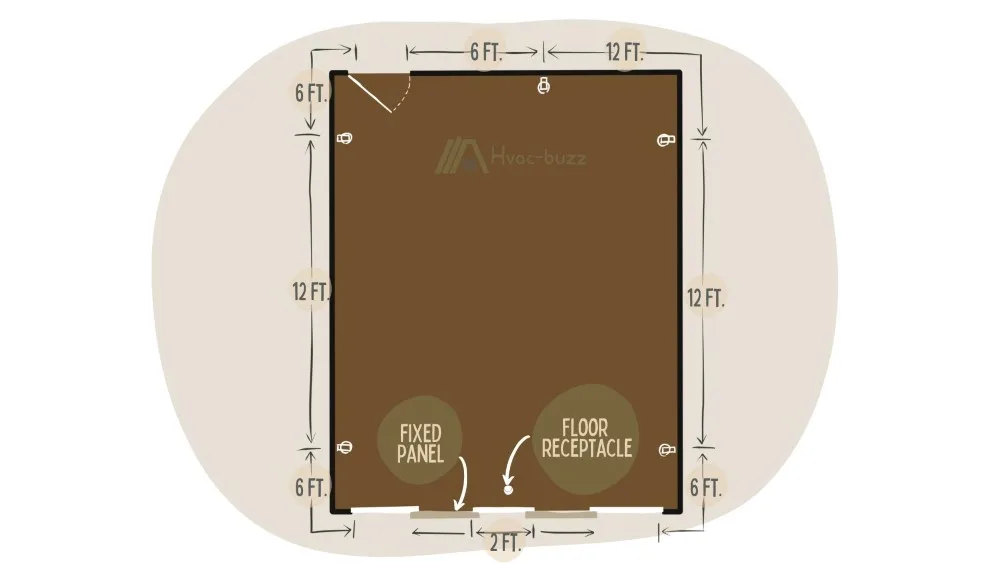
This is the receptacle spacing guide (Section E3901.2 of the IRC) for general living areas, including or similar to the following:
- Bedrooms
- Sunrooms
- Kitchens
- Dining rooms
- Living rooms
- Libraries
- Dens
- Parlors
- Family rooms
- Recreation rooms
Section E3901.2.1 (IRC) says that you need to have a receptacle outlet for every horizontal 6 ft measure of wall space (according to the floor line).
This wall space, according to Section E3901.2.2, includes widths of 2 ft that are unbroken (even if this goes around a corner), any space that has a fixed panel (though not sliding panels), and space constructed by fixed room dividers.
Section E3901.1 of the IRC states that:
“Permanently installed electric baseboard heaters equipped with factory-installed receptacle outlets, or outlets provided as a separate assembly by the baseboard manufacturer shall be permitted as the required outlet or outlets for the wall space utilized by such permanently installed heaters.”
Permanently installed outlet receptacles that are installed in an electric heater’s baseboard or the baseboard provided by the manufacturer do count as a wall outlet. The only qualifier is that they must not be connected to the electrical circuits of the heater.
This means that if the receptacle outlet is permanently installed with the heater, but is not a part of the heater’s electrics directly, then these can be considered as one of the required wall space receptacle outlets.
Outlets That Do Not Count
There are a few electrical outlets that are not considered to be applicable as one of the required wall space electrical outlets.
Section E3901.2.3 (IRC) states that unless they are within 18” of the wall, floor receptacle outlets don’t count towards the required number of electrical outlets.
The receptacle outlets on countertops and similar work surfaces do not count towards the wall spacing guides either, according to Section E3901.2.4.
This means that when you are installing the electrical outlets along wall spaces, any that are found on the floor further than 18″ from the wall or are located in some countertop/worktop space do not count as an electrical outlet.
You should be measuring your 6 ft according to other electrical outlets on the walls or any floor outlet that lies below 18″ away from the wall.
Other electrical outlets that do not count as part of this regulation, per Section E3901.1, are those that are a part of a light source or appliance, are in a cupboard/cabinet, that are controlled by a listed wall-mounted device, or that sit above 5.5 ft off the ground.
General Height of Outlets in Finished Basements
There are no specified heights for electrical outlets in finished basements.
You should check your local codes to ensure there are no state or location-specific height restrictions.
Commonly, the lower quarter of walls is a popular spot for installing electrical outlets. Section E3901.1 (IRC) does state that electrical outlets above 5.5 ft (1676 mm) are not considered part of the required receptacles for wall spacing.
So, this means that because your finished basement is treated the same as above-ground living areas, then you may want to comply with this height limit. It will make code compliance a little more straightforward.
There are different regulations for electrical outlets that are located on countertops, in bathrooms, and that are utilized for appliances, which are discussed in the sections below.
Appliance Outlets
Appliance outlets must be installed within 6 ft of where you intend to install the appliance, according to Section E3901.5 of the IRC.
Electrical outlets for appliances are relevant for kitchen and laundry appliances, as well as other main household appliances such as ventilation units, water heaters, furnaces, and air conditioning units.
Bathroom Outlets
Contrary to what you may think (i.e., water and electricity are a no-go), the IRC states in Section E3901.6 that at least one electrical outlet must be in the bathroom.
Of course, you must be using a listed product for the outlet receptacle, and I wouldn’t go crazy with the number of outlets in the bathroom. It is also important to note here that while outlets are mandatory, installing a subpanel in a bathroom is against IRC regulations.
The electrical outlet must be on a wall or partition next to the basin, on the side or face of the basin cabinet, on the counter, and all within 36” of the outside edge of the basin. It must not exceed 12” below the counter or basin level.
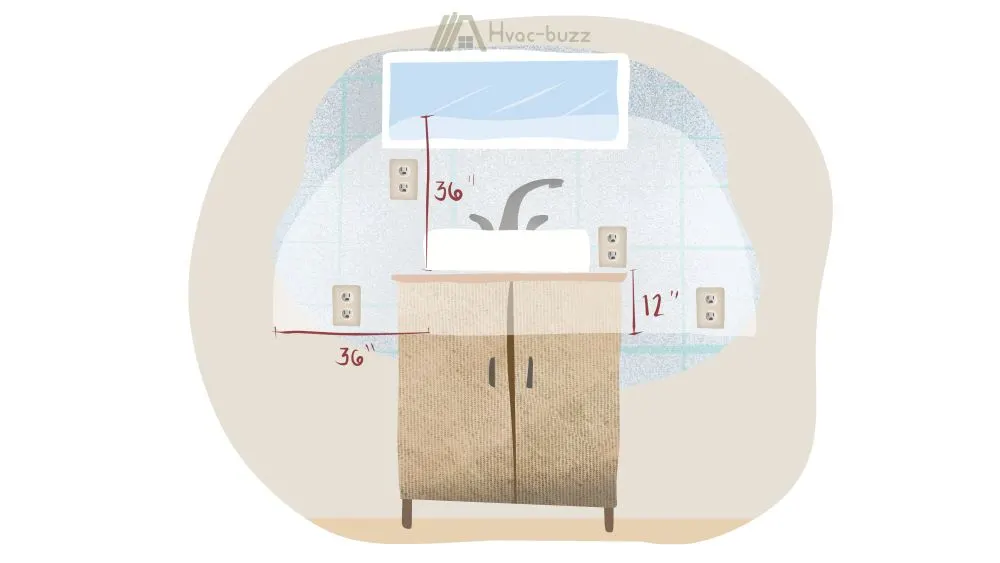
Hallway Outlets
There is a certain number of plugs required in hallways depending on how long they are.
Measuring your hallway down the centerline without crossing through a doorway is how you can calculate the length of your hallway.
Section E3901.10 of the IRC states that there must be one or more receptacle outlets in a hallway that is or exceeds 10 ft.
Practically, you could say that you would add a second (if not more) outlet if the hallway exceeds 10 ft.
Foyer Outlets
According to Section E3901.11 (IRC), if it is not part of a hallway and is bigger than 60 ft2, foyers are to have an outlet installed on every space of wall that is at least 3 ft wide.
Any doorways, sidelights, or similar openings that go down to the floor are not considered to be wall spaces and don’t count.
Countertop and Work Surface Outlets
In living areas of your home where work surfaces and countertops that are 12” or wider, receptacle outlets should be installed according to the code regulations in Section E3901.4 of the IRC.
A receptacle outlet should be installed at wall countertops so that no point in the area is further than 24″ from the receptacle. You, however, don’t need a receptacle outlet on a wall where it would fall behind a range hood, cooker, or sink unit as they must be readily accessible.
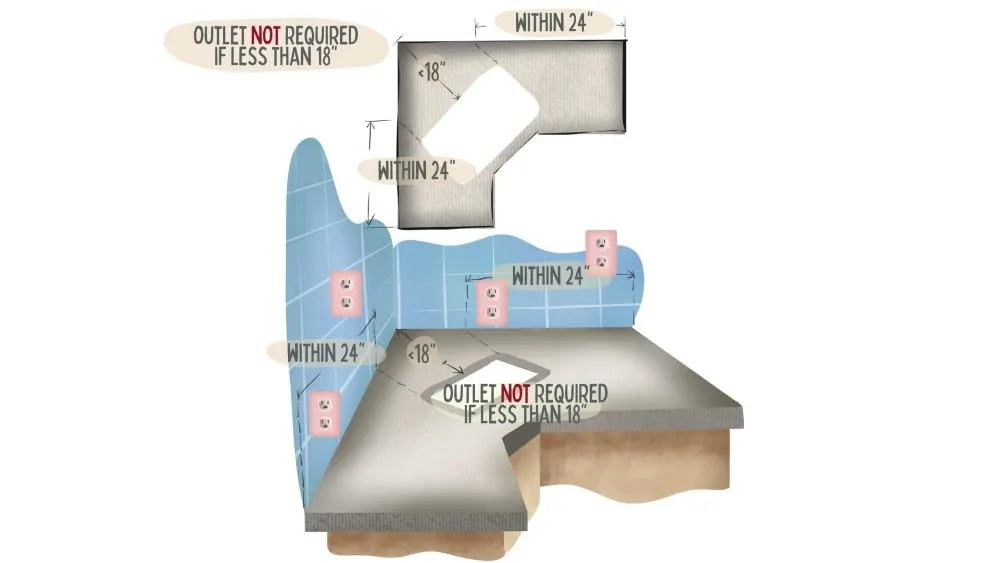
For island and peninsular counters, an electrical outlet should be installed for the first 9 ft2 (or the appropriate fraction thereof) of the space, and then you will need an additional plug for any further 18 ft2.
You need a plug within the end 2 ft of a peninsular counter, and additional electrical outlets are going to be according to the building owner, installer, or designer. This counter is measured from the connecting wall.
According to Section E3901.4.3 of the IRC, the required receptacle outlets shall be located per one or more of the following guides:
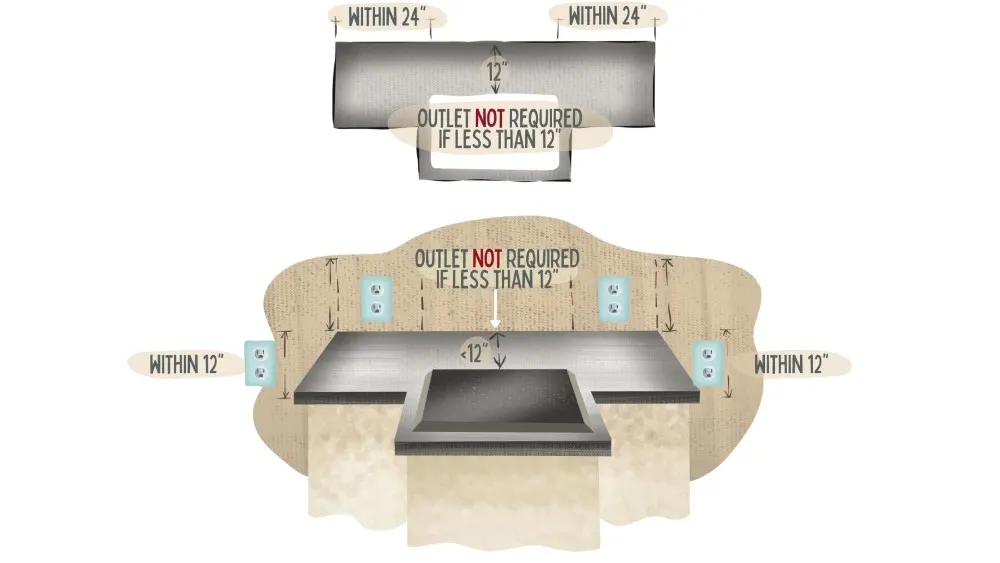
- On or above (without exceeding 20”) the surface.
- Installed into the counter or surface as per permission for a listed receptacle outlet.
- At a maximum distance of 12” under the surface, as long as the installation is not located where the counter extends over 6” from the base.
GFCI and AFCI Protection in a Finished Basement
As mentioned earlier, basement areas (regardless of their finished or unfinished state) require GFCI protection, according to IRC Section E3902.5.
In addition to this circuit-breaker safety for your receptacle outlet, because a finished basement is considered as a living area, you are also required to have arc-fault circuit-interrupter (AFCI) protection.
AFCI protection is required in the following and other similar areas according to Section E3902.17 of the IRC:
- Bedrooms
- Sunrooms
- Kitchens
- Dining rooms
- Living rooms
- Libraries
- Dens
- Parlors
- Family rooms
- Recreation rooms
- Closets
- Laundry rooms
- Hallways
AFCI protection is designed to protect people from fires occurring in the electrical system when there is an arc fault by tripping the circuit. This is a fault in the branch circuit and requires an electrician to source and address the problem.
Now that you are fully informed about basement outlets, the next step is to understand the code surrounding basement wiring and conduit use.
Sources
https://files.dep.state.pa.us/Mining/Deep%20Mine%20Safety/lib/deepminesafety/training/electerms.pdf
https://www.electrical-online.com/electrical-outlet-or-electrical-receptacle/
https://inspectapedia.com/electric/Electrical_Outlet_Height.php#Ht
